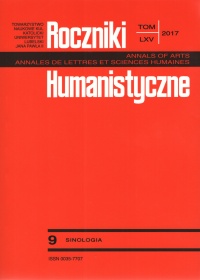Wsparcie rozwojowe i współpraca gospodarcza Chińskiej Republiki Ludowej z Afganistanem
Abstrakt
Celem artykułu jest prezentacja i ocena wsparcia rozwojowego udzielanego przez rząd Chińskiej Republiki Ludowej Afganistanowi oraz współpracy gospodarczej między tymi państwami. Autor przedstawia motywy, okoliczności i perspektywy tych działań. W artykule postawiono dwie główne tezy. Po pierwsze, wsparcie rozwojowe udzielane przez rząd ChRL Afganistanowi jest bardzo ograniczone. Wynika to głównie z faktu, że władze w Pekinie nie chcą wspierać działającej pod amerykańskim przywództwem koalicji międzynarodowej w Afganistanie. Po drugie, współpraca gospodarcza między państwami także jest ograniczona, co jest konsekwencją przede wszystkim niestabilnej sytuacji w kraju. Odstępstwem od tej reguły są relatywnie duże inwestycje chińskich przedsiębiorstw w sektor wydobywczy Afganistanu.
Bibliografia
Ali, Mahmud. „Peripheral South Asian response to the growth of Chinese power: a study in dichotomous continuity”. W: Mingjiang Li i Kalyan M. Kemburi, eds. China’s Power and Asian Security, 111–138. London, New York: Routledge, 2015.
Arduino, Alessandro. „China’s Energy Interests in Central Asia and Russia: Symbiotic distrust and striking a balance between cooperation and confrontation”. W: Fengshi Wu i Hongzhou Zhang, eds. China’s Global Quest for Resources: Energy, Food and Water, 119–137. London, New York: Routledge, 2017.
Central Statistics Organization of Islamic Republic of Afghanistan. Statistical Yearbook 2016-2017. Trade. Dostęp 27.10.1017. http://cso.gov.af/en/page/1500/4722/2016-17.
Cordesman, Anthony, i Ashley Hess. „Transition in the Afghanistan-Pakistan War and the uncertain role of the great powers”. W: Joachim Krause i Charles King Mallory, eds. Afghanistan, Pakistan and Strategic Change. Adjusting Western regional policy, 70–148. London, New York: Routledge, 2014.
Crane, Keith, i Victoria Greenfield. „The NATO drawdown: implications for Afghanistan and Pakistan”. W: Joachim Krause i Charles King Mallory, IV, eds. Afghanistan, Pakistan and Strategic Change. Adjusting Western regional policy, 269–289. London, New York: Routledge, 2014.
Curtis, Lisa. „China’s South Asia Strategy”. The Heritage Foundation. Testimony Asia. 17 March 2016. Dostęp 14.07.2017. http://www.heritage.org/testimony/chinas-south-asia-strategy.
Downs, Erica. „China Buys into Afghanistan”. SAIS Review 32 (2012), No. 2: 65–84.
ENGLISH.GOV.CN. The People’s Republic of China. The State Council. „A Joint Statement between the People’s Republic of China and the Islamic Republic of Afghanistan”. Beijing: 20 June 2006. Dostęp 10.07.2017. http://www.gov.cn/misc/2006-06/20/content_315724.htm.
Gacek, Łukasz. Azja Centralna w polityce energetycznej Chin. Kraków: Wydawnictwo Uniwersytetu Jagiellońskiego, 2013.
Gajda, Jakub. „Zaangażowanie Chin w Afganistanie — stan obecny i perspektywy”. Biuletyn Opinie FAE 2015, nr 4: 1–9.
Gartenstein-Ross, Daveed, Daniel Trombly i Nathaniel Barr. Chinas Post-2014 Role in Afghanistan. Washington: Foundation for Defense of Democracies, October 2014.
Głogowski, Aleksander. „Chiny – Pakistan – Afganistan. Nowe mocarstwo wobec starych wyzwań”. W: Robert Kłosowicz, Bogdan Szlachta, Janusz Józef Węc, red. Dylematy strategiczne XXI wieku. Księga Jubileuszowa dedykowana Profesorowi Michałowi Chorośnickiemu z okazji czterdziestolecia pracy naukowej, 263–272. Kraków: Księgarnia Akademicka, 2013.
Harpviken, Kristian Berg. „A peace nation in the war on terror: the Norwegian engagement in Afghanistan. W: Nik Hynek i Péter Marton, eds. Statebuilding in Afghanistan. Multinational contributions to reconstruction, 157–173. London, New York: Routledge, 2012.
Harsehé, Rajen. „Situating Afghanistan in a globalizing world”. W: Rajen Harsehé i Dhananjay Tripathi, eds. Afghanistan Post-2014. Power configurations and evolving trajectories, 17–32. New Delhi, London, New York: Routledge, 2016.
Hausheng, Zhao. China and Afghanistan. China’s Interests, Stances, and Perspectives. A Report of the CSIS Russia and Eurasia Program. Washington: Center for Strategic & International Studies, March 2012.
International Copper Study Group. The World Copper Factbook 2016. Dostęp 10.07.2017. http://www.icsg.org/ index.php/component/jdownloads/finish/170/2202.
International Trade Centre (ITC), Geneva. Dostęp 10.07.2017. „Bilateral trade between Afghanistan and China”. http://www.trademap.org/tradestat/Bilateral_TS.aspx?nvpm=1|004||156||TOTAL||| 2|1|1|1|2|1|1|1|1.
International Trade Centre (ITC), Geneva. Dostęp 10.07.2017. „Bilateral trade between China and Afghanistan”. http://www.trademap.org/tradestat/Bilateral_TS.aspx?nvpm=1|156||004||TOTAL||| 2|1|1|1|2|1|1|1|1.
Lanteigne, Marc. Chinese Foreign Policy. An Introduction. Third Edition. London, New York: Routledge, 2016.
Levi-Sanchez, Suzanne, The Afghan-Central Asia Borderland. The state and local leaders. London, New York: Routledge, 2017.
Ministry of Foreign Affairs. Islamic Republic of Afghanistan. „China-Afghanistan Joint Statement on Deepening Strategic and Cooperative Partnership”. Beijing: 7 November 2014. Dostęp 10.07.2017. http://mfa.gov.af/en/news/china-afghanistan-joint-statement-on-deepening-strategic-and-cooperative-partnership.
Opacin, Nerkez. China’s Role in Afghanistan. A Capitalist Peace Approach. Hamburg: Anchor Academic Publishing, 2015.
Pantucci, Raffaello. „Commentary: China’s expanding security role in Afghanistan”. Reuters, 1 March 2017. Dostęp 06.07.2017. http://www.reuters.com/article/china-afghanistan-securityrole-idUSKBN1683QY.
Pantucci, Raffaello, i Alexandros Petersen. „China Digs in to Afghanistan”. The National Interest. 24 May 2012. Dostęp 06.07.2017. http://nationalinterest.org/commentary/china-digs-afghanistan-6961? page=2.
Roberts, Guy C. US Foreign Policy and China. Bush’s first term. London, New York: Routledge, 2015.
SIGAR. Special Inspector General for Afghanistan Reconstruction. „Quarterly Report to the United States Congress”. 30 January 2015. Dostęp 14.07.2017. http://reliefweb.int/sites/reliefweb.int/ files/resources/ 2015-01-30qr.pdf.
Szczudlik-Tatar, Justyna. „Towards More Rebust Diplomacy with ‘Chinese Characteristics’”. PISM Strategic File 2014, No. 22 (58): 1–6.
Wywiad autora z Marcinem Krzyżanowskim, byłym konsulem RP w Kabulu, Prezesem Zarządu Ariana Trade Group sp. z o.o.
Zaborowski, Wojciech. „Polityka Chin wobec Afganistanu w kontekście zakończenia misji ISAF”. Bezpieczeństwo Narodowe 2012, nr III-IV (23–24): 141–164.
Zafar, Athar, Dinoj K. Upadhyay. „Drawdown from Afghanistan: implications for India’s engagement in Central Asia”. W: Rajen Harsehé i Dhananjay Tripathi, eds. Afghanistan Post-2014. Power configurations and evolving trajectories, 231–244. New Delhi, London, New York: Routledge, 2016.
Copyright (c) 2017 Roczniki Humanistyczne

Utwór dostępny jest na licencji Creative Commons Uznanie autorstwa – Użycie niekomercyjne – Bez utworów zależnych 4.0 Międzynarodowe.





